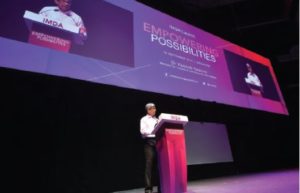Singapore’s media sector has been performing strongly, posting a compounded annual growth rate (CAGR) of 6.8%. In 2010, the industry contributed S$6.4 billion in value-added (VA) and S$23.9 billion revenue to the economy and employed some 66,000 workers. Singapore’s media sector consists of several industries, including TV broadcast and production; publishing and printing; film; music; as well as interactive and digital media. Interactive and Digital Media – which includes video games, animation, online/mobile media and new forms of digital entertainment – has skyrocketed into a multi-billion dollar business.
 The global video games industry (excluding hardware sales) is expected to swell from US$56 billion in 2010 to US$82 billion by 2015, with Asia registering the fastest growth, according to the PriceWaterhouseCoopers’ Global Entertainment & Media Outlook. Singapore’s animation and games industries are seeing rapid expansion. Singapore is seeing an influx of leading digital media companies such as Tecmo-Koei, Lucasfilm, Double Negative, Electronic Arts and Ubisoft. Local companies like Ratloop Asia, Sparky Animation and Scrawl Studios have also responded eagerly too, producing original content for export and entering strategic partnerships with international distributors. According to Deloitte, Singapore’s games and animation industries, together with online/mobile media, have demonstrated robust growth, posting a CAGR of 26% from 2006- 2010. In 2010 it contributed $1.2 billion in VA and $1.5 billion revenue to the economy and employed an estimated 11,000 workers. Singapore is an ideal location for creating and deploying new content and for managing intellectual property (IP), as it has the best IP protection in Asia and a large, multilingual talent pool in both traditional and new media. Development and animation studios and companies which provide game hosting will also find Singapore attractive due to the island’s large pool of graduates in IT and programming.
The global video games industry (excluding hardware sales) is expected to swell from US$56 billion in 2010 to US$82 billion by 2015, with Asia registering the fastest growth, according to the PriceWaterhouseCoopers’ Global Entertainment & Media Outlook. Singapore’s animation and games industries are seeing rapid expansion. Singapore is seeing an influx of leading digital media companies such as Tecmo-Koei, Lucasfilm, Double Negative, Electronic Arts and Ubisoft. Local companies like Ratloop Asia, Sparky Animation and Scrawl Studios have also responded eagerly too, producing original content for export and entering strategic partnerships with international distributors. According to Deloitte, Singapore’s games and animation industries, together with online/mobile media, have demonstrated robust growth, posting a CAGR of 26% from 2006- 2010. In 2010 it contributed $1.2 billion in VA and $1.5 billion revenue to the economy and employed an estimated 11,000 workers. Singapore is an ideal location for creating and deploying new content and for managing intellectual property (IP), as it has the best IP protection in Asia and a large, multilingual talent pool in both traditional and new media. Development and animation studios and companies which provide game hosting will also find Singapore attractive due to the island’s large pool of graduates in IT and programming.
For companies in the printing and publishing sector, Singapore is a nexus for Asian financial and professional news, and a cost-effective printing and distribution hub. Singapore offers proximity and excellent connectivity to regional markets – markets that have a tremendous appetite for interactive media and digital media entertainment. As a cosmopolitan, urbanised Asian city-state, it offers a unique blend of Eastern and Western cultural influences. The government has also put in place policies to attract and retain talent from all over the world, creating a melting pot of creative talent for companies to tap into. Since the 1990s, Singapore has attracted a number of global broadcasters to its shores. There are now a large number of major broadcasting networks up linking their channels from Singapore to their regional audiences. These include Discovery Networks Asia Pacific, CNBC Asia Pacific and ESPN Star Sports. From broadcast, the sector has progressed into content production. One example is the 2011 AXN reality series Cash Cab Asia. Produced by AZN, the project was filmed in Singapore, with post-production work undertaken by Active TV. Over the years, Singapore-made TV content has gained recognition, winning international awards and entertaining audiences from some 70 countries around the world. Award winning content from Singapore includes factual entertainment series Very!’s Chasing Happiness, which won a Rockie at the BANFF World Media Festival in 2013; and The Great Elephant Gathering by Beach House Pictures, which reaped a Silver Medal Award for the Nature & Wildlife category at the New York Festivals 2013.
Moving from providing services-forhire to co-owning and creating original content, Singapore media companies have also proven to be strong co-production partners. An example is Serangoon Road, where Singapore-based Infinite Studios partnered with HBO Asia, Australia Broadcasting Corporation (ABC) and Western Australia to co-produce HBO Asia’s first original series. Serangoon Road is a ten episode hour-long detective series set against the tumultuous backdrop of 1960s Singapore. Other recent co-productions include Kakadu, a documentary series on Kakadu National Park in Australia by Beach House Pictures, Northern Pictures and ABC. Beyond producing content for television, more producers are exploring transmedia storytelling and new formats, extending the TV experience to multiple platforms. Notable multi-media content created include Mediacorp’s drama 96°C Café and Beach House Pictures’ Hidden Cities Extreme, a travel and adventure series. 96°C Café was fi rst telecast online on xinmsn.com and continued its run as a 20-episode series on free-to- air (FTA) TV; while Hidden Cities Extreme had viewers engaged on its Facebook page which shared videos, images and upcoming episodes of the programme. In addition, being strategically located in Asia, with excellent content production, aggregation, distribution and broadcasting capabilities and a burgeoning creative community, Singapore has become the natural home and springboard to other parts of Asia for some of the world’s most established global media companies. They include AXN, BBC, CNBC Asia, Discovery Asia, FremantleMedia Enterprises, HBO Asia, MTV Asia, Nickelodeon and Walt Disney Television.
Increasing initiatives to improve industry standards
Recognising the industry’s need to better understand pay-TV viewing and its reach, StarHub partnered Nielsen to launch StarHub SmarTAM, Singapore’s first Television Audience Measurement system using Return Path Data (RPD) technology, late September 2015. StarHub has also commissioned Nielsen to support the subscription and sales of SmarTAM data.The TV audience measurement system tracks both real-time and time-shift viewing of TV content and advertising spots across more than 200 StarHub TV channels. StarHub SmarTAM has the ability to provide highly accurate and dynamic audience segmentation, track specific media consumption habits and facilitates advertising campaign re-targeting beyond TV in real-time. The Beijing Film Academy (BFA) and Singapore Media Academy (SMA) announced in October 2015, the launch of the prestigious curriculum of the Diploma in Film-making in Singapore. BFA and SMA are hoping to nurture the next generation of media leaders who are truly international through this cross-cultural collaboration. SMA will accept the first intake of the diploma course in early 2016. The SMF this year has opened up more avenues for strategic partnerships, creative collaborations and investment opportunities into the region. This is most evident from the South-east Asian Film Financing Project Market (SAFF) where 10 in development fiction and non-fiction feature film projects will be matched with commissioners, investors and co-production partners. The SAFF received an overwhelming response with a total of 148 project submissions from 22 countries as at 30 September this year. ATF 2016 will also host several master classes for budding producers.
On the global-scale
In other news, Viddsee raised USD2.3 million after bringing Japan-based CyberAgent Ventures (CAV) as lead investor in its latest round of funding to develop the new wave of mobile-powered cinema, starting with Asia. Singapore stormed to the global market when it headed to MIPCOM 2015 with more than 600 hours of Asian content. MDA had led a delegation of 16 Singapore media companies to Cannes, including live action and animation producers, as well as distributors. In October 2015, MDA, MediaCorp and Oak3 Films announced that Spelling Armadillo has been nominated for the 4th International Emmy Kids Awards in the category of Kids: TV Movie / Mini-Series. This is the fi rst time a South-east Asian production is nominated under the Kids: TV Movie / Mini-series category in the International Emmy Kids Awards. The Singaporean market has been growing steadily for the past year.
The media industry has been receiving a spike in support from areas including fi nancing, platforms to showcase work and more. Singapore has been recognising the TV and film industry a lot more recently with the introduction of various grants and schemes in place, as well as the introduction of festivals and events to showcase talents.
Infocomm and media convergence to offer opportunities for all
The Info-communications Media Development Authority (IMDA) was officially launched following the restructuring of the Info-communications Development Authority (IDA) and the Media Development Authority (MDA). Minister for Communications and Information Dr. Yaacob Ibrahim announced IMDA’s strategies to spearhead Singapore’s transition into a digital future by helping businesses, workers and the community to harness the opportunities from Info-comm Media (ICM) convergence and technological change at the event. The new IMDA logo, signifying the abundant opportunities in the ICM sector, was unveiled as well. IMDA will roll out plans to help businesses take advantage of ICM and technology to grow. Urban logistics solutions can reduce the number of trucks on the road, cut delivery manpower, and reduce the in-waiting and queuing time for deliveries. IMDA will launch the Smart Facility management (Smart FM) initiative, which will help Small and Medium-sized Enterprises (SME) service providers.
IMDA is collaborating with local media company Beach House Pictures to take students on immersive and interactive virtual journeys for their lessons on social studies. The use of VR will also be used in medical training, which will allow healthcare professionals to be trained in lifesaving skills and procedures in a risk free environment. IMDA will expand the Accreditation@ IMDA (A@IMDA) programme to help start-ups in the media sector through collaboration with Mediacorp on their Mediapreneur incubator programme. IMDA will be collaborating with the National Council of Social Service (NCSS) to partner three social service organisations to reach out to low income households. Minister said, “IMDA’s success ultimately depends on whether it has used ICM to empower possibilities for all Singaporeans, and not just a few. While other countries grapple with digital divides, IMDA will help us generate a digital multiplier for our people.” The Info-Communications Media Development Authority (IMDA) and Discovery Networks Asia-Pacific (DNAP) announced a year-long partnership designed to up skill and co-create content with emerging and established production companies in Singapore using the most advanced techniques and technologies including 4K and Virtual Reality (VR). This content will premiere on Discovery’s platforms globally. Driven by Discovery Networks International (DNI) and DNAP, the USD$5 million (or SGD$6.8 million) year-long partnership is designed to both nurture new and upcoming producers, as well as give Singapore’s established producers the opportunity to showcase their expertise to a global audience. Local producers will have the opportunity to learn the latest techniques, train in using new technologies, and experiment with various content formats and present them across multi-channel platforms that will travel across the Discovery global network. Using public data sets from Tableau Public, government websites and other sources, this competition invites participants to create data-driven stories around the themes of “Sports” “Science and Environment” or “City and Culture.” The students compete in groups of three, working with support from their teachers.
The Race is on
The Amazing Race Asia Season 5 gives die-hard fans unprecedented access to the racers throughout the series through multiple social platforms. The Amazing Race Asia Season 5 is a socially charged, thrilling adventure where viewers can interact with the 11 fearless teams in each episode. The races will candidly share their experiences via their own team hashtags as the drama unfolds on screen each week. Celebrity host Allan Wu (#TARAAllan), and his new co-host, Indonesian movie star Tara Basro (#TARATBasro) will also chat with fans. “For this season we had a dedicated social content crew physically running the race with the teams to capture all the behind-the-scenes fun and drama,” said Virginia Lim, Senior Vice President and Head of Content, Production and Marketing, Sony Pictures Television Networks, Asia. At the end of each episode, AXN encourages viewers to virtually hang out with the newly eliminated team via Facebook Live at Facebook.com/ TheAmazingRaceAsia where fans can commiserate and ask questions about their race experience. Then, every Saturday at 1:10pm, fans will have the chance to Facebook Live chat with the winning teams who were first to arrive at the pit stop. In addition to the Facebook Live chats, AXN unleashes a series of webisodes created exclusively for social platforms like Facebook, providing a raw and honest account of what goes on behind the scenes of the race. The Amazing Race Asia season 5 kicks off in the bustling city of Jakarta at the starting line. At Monas, the National Monument of Jakarta, host Allan Wu and co-host Tara Basro deliver the first shocking twist of the season – only 10 of the 11 teams will have a real shot at winning USD100,000. One team is set to be eliminated within the first 20 minutes of the episode. The exclusive behind-the-scenes look at the Race is available at www.AXN-Asia.com/TARA.The Amazing Race Asia Season 5 is supported by presenting sponsor Wonderful Indonesia, and partners Garuda Indonesia, Grab and Great Eastern.







